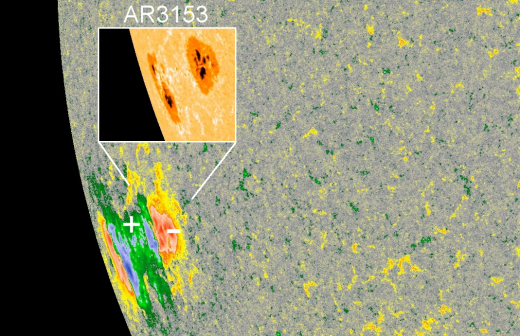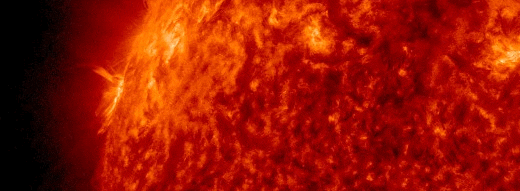Sun: There is a large active Great Spot with two cores larger than Earth
Spaceweather.com has reported the presence of a new sunspot, a very powerful one. She was reportedly spotted by one of NASA's observation instruments. “A new sunspot (AR3153) is rotating on the southeastern limb of the Sun, and it is very large. NASA's Solar Dynamics Observatory (SDO) is seeing at least two dark cores significantly larger than Earth,” noted spaceweather.com.
The site noted that for now the sunspot solar flares are not dangerous, a danger sometimes associated with sunspots. “So far the sunspot's magnetic field appears to be sharply separated into + and – polarities, with no mixing. This means that it poses no threat from explosive solar flares. However, the situation could change. The sunspot is growing rapidly, doubling in size since yesterday, so its magnetic architecture could soon be very different."
This is what its static image looks like
Here is how a spot looks dynamically with the solar wind filaments projected outwards (this is 3157)
Solar flares occur when areas of the Sun develop strong magnetic fields that temporarily halt the convection process on the Sun. Because of this, they send out intense bursts of electromagnetic radiation from the Sun that can disrupt spacecraft that provide communications and navigation services. These vehicles can even take critical damage.
The National Oceanic and Atmospheric Administration (NOAA) classifies solar flares into five categories that indicate the amount of radiation released. Classes A, B and C are flares of relatively low intensity that do not cause any influence on the Earth.
A new sunspot has two dark nuclei larger than the EarthAR3153 However, M- and X-class flares are more powerful, and X-class flares are even 10 times more powerful than M-class solar flares.
Each class is further subdivided on the logarithmic scale from 1 to 9, except for class X, which continues further. Class X flares are mostly rare, and the instrumentation developed so far can only accurately measure solar flares up to the intensity of X16.
According to EarthSky.org, AR3153 has produced only eight class C flares and two class B flares thus far. It is also forecast for a 60-minute explosion. Furthermore, predictions speak of a 60% chance of class C flares, a 15% chance of class M flares, and only a 5% chance of class X flares. Also, no coronal mass ejections are expected ( CME) from this sunspot and the chances of geomagnetic storms are extremely low through at least December 3, 2022.
This is great news, especially when compared to other sunspots reported in the past. Just last September, a huge sunspot, potentially capable of emitting powerful solar flares, was pointing straight at Earth. Even if 3153 were to take the direction of the Earth and have a class X flare it could seriously disturb radio and satellite communications, especially since it is a delicate communications system sensitive to fluctuations in the solar wind.

Thanks to our Telegram channel you can stay updated on the publication of new articles from Economic Scenarios.
The article Sun: there is a large active large spot with two cores larger than the Earth comes from Scenari Economics .
This is a machine translation of a post published on Scenari Economici at the URL https://scenarieconomici.it/sole-ce-una-grande-macchia-attiva-grande-con-due-nuclei-piu-grandi-della-terra/ on Sun, 04 Dec 2022 14:50:33 +0000.


